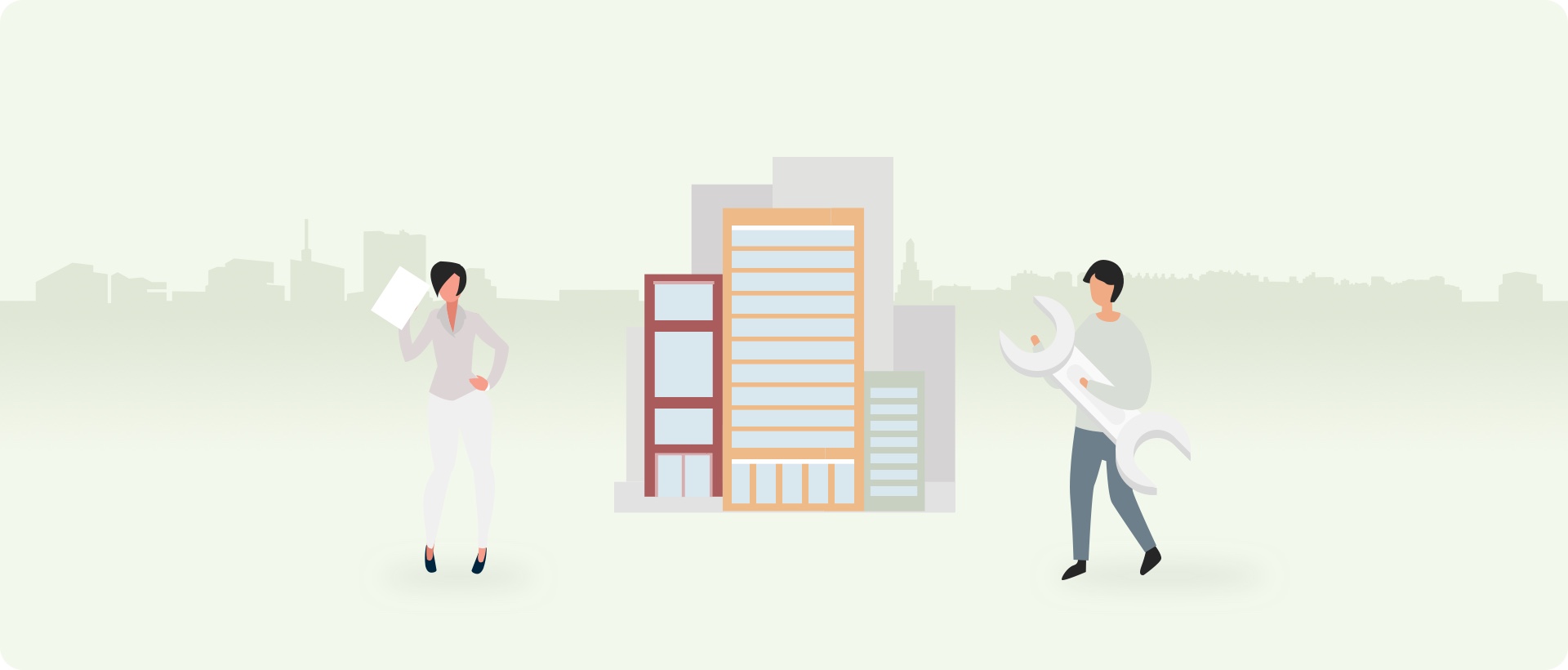Although we all wish for it, life and business won’t go “back to normal” anytime soon, at least not the normal that we knew before lockdown.
Instead, we will probably have to get used to a new normal, a post-COVID-19 normal. A new normal that will involve adhering to freshly implemented social distancing rules, wherever possible, and that includes the workplace too.
So what can you do now to get your workplace and your workforce ready to thrive in the “6-feet economy” or “new normal”of the post-COVID-19 era?
What’s in?
Like what you see?
Don’t miss out. Subscribe to our monthly digest to get the latest TA and TM resources delivered right to your inbox.
Workplace changes
Office
If you work in an office environment, workstations, especially seats, need to be at least 6 feet apart.
Take inspiration from Cushman & Wakefield who have started the 6 Feet Office Project, with the aim to get the world back up and running as quickly as possible.
They recommend welcoming everyone back to work, but encouraging all employees to act responsibly, by sticking to the rules and following any signage you put up around the office, for example:
- Posters instructing employees to always walk around your office clockwise.
- To walk down corridors sticking to one (right- or left-hand) side.
- To enter and leave meeting rooms as indicated.
- To clean their desk down whenever employees leave it.
If you have the space to move your workstations apart, great. If you don’t have enough space to separate workstations, you’ll need to think of another way to protect employees from one another. One such way could be installing physical barriers, such as the ones seen in supermarkets at the checkouts.
These plexiglass barriers will protect employees from each other without breaking up the open-plan nature of your office.
As well as ensuring employees adhere to social distancing when they are working, you’ll also want to reduce their contact with “contact points” e.g. fingerprint scanners or even just door handles.
- Think about switching to key cards for entry into secure locations.
- If doors need to be shut, you might think about installing hand sanitizer dispensers beside each door for employees to sanitize their hands after touching the door handle.
- Or simply leave a roll of blue paper, or paper towels beside each door so that employees don’t need to physically touch the door, they can use the paper as a barrier.
- Or you could install brass door handles – these are renowned for their antibacterial properties.
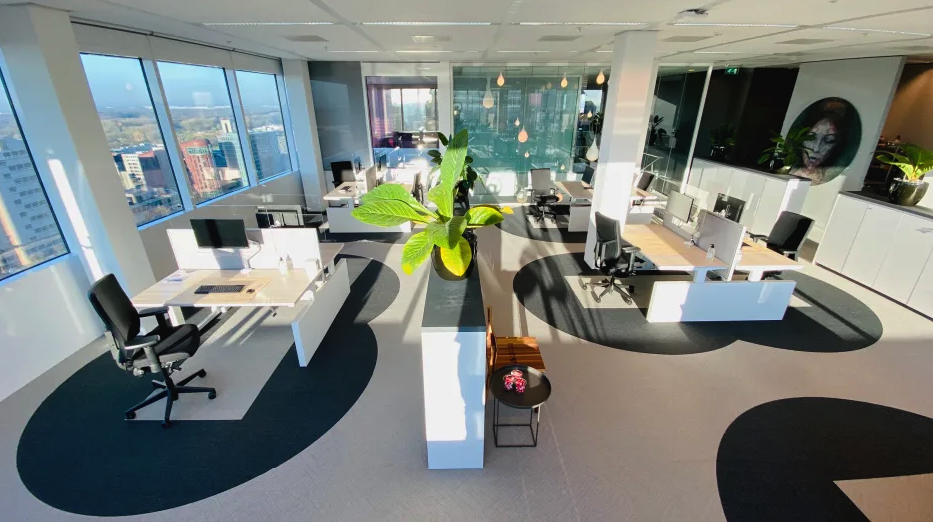
Cushman & Wakefield envision the 6-feet office with clear visual aids helping employees maintain a safe distance.
Hospitality
In some places, establishments like restaurants, cafes, and bars have been allowed to reopen, but with certain limitations.
In Canberra, Australia, for example, they’ve introduced a new 4 square meter rule for cafes, pubs, and indoor spaces. This means that you are only allowed one patron per every 4 square meters. This dramatically reduces your footfall, but it’s a way for businesses to re-open safely.
Think about how you can rearrange your seating to ensure a safe distance between your guests. If your hospitality business has any outdoor spaces, look into options of utilizing them to host your guests, as the outdoor terraces are reopening first, not to mention that your guests might feel safer out in the fresh air just after the pandemic.
Stores
In Indiana, the Governor has implemented new restrictions to help curb the spread of coronavirus, while allowing stores to remain open, as long as they comply with these new social distancing requirements.
- Stores have to limit the number of customers they can have in the store at any one time.
- They must instruct customers to follow a one-way system up and down the aisles.
- They must limit their store opening hours and ensure the workplace is kept sanitized.
- Other ideas stores can implement are a one in one out policy.
- Relocating cash registers further away from each other so staff can maintain a safe working distance.
- Customers have to unload their trolleys at least 6 feet from cashiers onto a conveyor belt and pack their bags at least 6 feet from the cashier.
- If stores can’t physically distance staff from customers at the checkout, they could consider installing a clear plexiglass sneeze barrier to keep employees protected from contact with customers.
- Provide employees with the facilities to ensure they maintain good personal hygiene – employees must be encouraged to regularly wash their hands with soap and water, to wear gloves where possible and to sanitize their hands frequently.
By implementing these measures, you’re able to ensure customer and employee safety in your retail business.
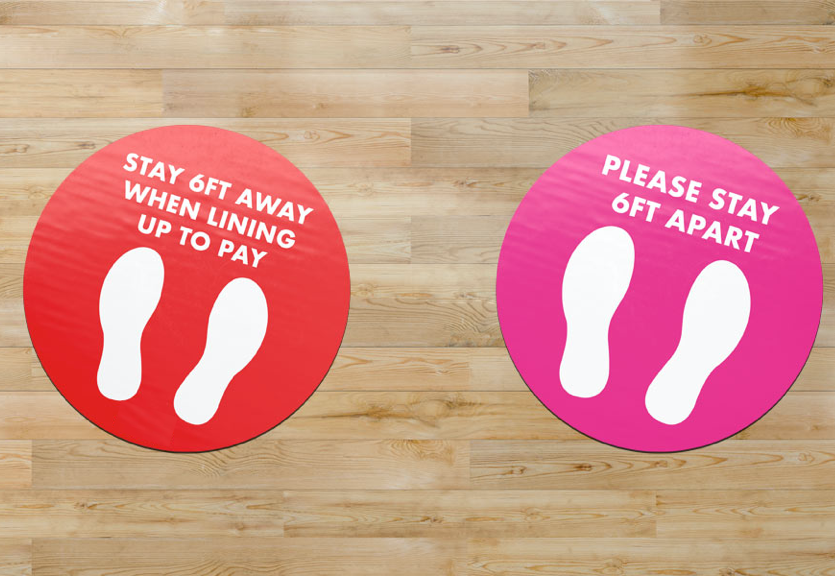
Simple floor stickers reminding shoppers to keep their distance will probably stay with us for a long time.
Utilizing technology to ensure social distancing
If you’re concerned about your employees not being able to remember to maintain 6 feet (or 1.5 or 2 meters) when working, you might consider utilizing technology to ensure they remain the required distance apart.
A startup that produces a wearable tech device to ensure the safety of their electrical industry workers, has adjusted their device to address the need to maintain social distance in offices. Proxxi, a Canadian company, is launching Halo, a device that is worn on the wrist and issues a vibration notification when the wearer is within 6 feet of another device.
Wearing such tech will allow workers to carry on as normal without the added pressure of having to remember to keep their distance from one another – they can rely on the device to let them know.
The device works two-fold in that it keeps a log of all the other devices it’s been in contact with, to enable tracing in case of positive coronavirus diagnosis.
Another simple smart device is Aura Aware. This device works straight out of the box and provides a convenient reminder for employees and customers to maintain the requisite 6 feet apart.
The patented technology scans a room and detects if anyone is within 6 feet. Because if truth be told, staying 6 feet apart doesn’t come naturally to humans. This device would be useful for queue management, for people who aren’t great at judging distances and to keep visitors (who may not be aware of your social distancing policy) away from your employees.

You could also look to introduce smart office technology, for example, to lead employees to areas with fewer people, sooner rather than later.
In the Bee’ah waste management company in Sharjah, UAE, they’ve created a space that is designed around ‘contactless pathways’, allowing employees to move around the building without having to touch any part of the building. An employee’s phone calls the lift as they approach, negating the need to press any buttons; the office doors open automatically through motion sensors and using facial recognition. Everything from ordering coffee to dimming the lights or adjusting the AC is all done through each employee’s smartphone.
Lunch breaks
Bear in mind that the social distancing rules must be followed during lunch breaks too, so how can you ensure that?
Ray Scott, president and CEO of Lear Corp., an automotive parts supplier based in Southfield, Michigan has used the recent downtime to develop and publish their own handbook for how to operate in a post-Covid-19 workplace.
One of his lunchtime recommendations is to ask half the workforce to eat in their cars or to eat outside, in order to free up chairs in the canteen. Another option to ensure adherence to social distancing at lunch is to write ‘yes’ and ‘no’ on the back of chairs to remind workers not to sit too close to one another.
Ventilation
It is easier for germs to spread in places that are not well ventilated. That’s why ensuring good ventilation should be among the first things to do before you let your employees enter the workplace again.
You can:
- Increase ventilation in shared spaces by adjusting the air conditioning.
- Open windows where possible.
- Install air filters and replace old ones.
Sanitation and disinfection
As an employer, you have a duty of care to ensure that your employees can work in a safe environment:
- Provide wipes and cleaning products so that your employees can clean their desks prior to and on completion of their work.
- Encourage the cleaning of common spaces frequently.
- Provide hand gel, soap, and clean washing facilities.
- And install signs to remind employees of the requirement to regularly sanitize and disinfect their work stations and their hands.
Providing personal protective equipment (PPE) if needed
If you run a high-risk work environment where social distancing is difficult to maintain, provide employees with PPE e.g. gloves and face masks for employees that are in close contact with customers, or if your employees are exposed to people with known cases of the coronavirus, such as healthcare workers.
Workforce changes
Providing training on new rules
The 6-feet economy in the post-COVID-19 era is going to be new for everyone – both you and your employees. So you need to train them on how they can best adhere to the new rules.
One way of doing this is to follow in Lear Corps’ footsteps and create a digital handbook containing your new rules and ways for working for your employees to read prior to returning to work.
Exploring new ways of working
- If you don’t have to have everyone back into the office immediately following the lockdown lifting, consider bringing people back to work in stages.
- If you run a shift schedule, keep an hour gap between the shifts to disinfect the space.
- Enforce a part-time compulsory WFH to reduce the number of people at the office at any one time, and have this on rotation.
- For hospitality businesses, consider having a pick-up at the bar system instead of offering table service.
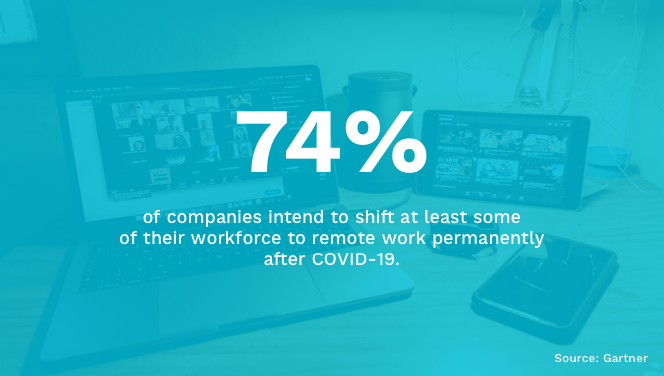
Shifting a part of your employees to remote work permanently could also help you limit the number of people at your workplace.
Retraining your employees on customer service
If you operate a “customer is always right” philosophy, it might need to change a bit. Your employees will need to be assertive and ensure that the customers stick to the new rules within your store or hospitality business. Train your workers on how to communicate the new 6-feet rules to your customers and also on what to do if the customers refuse to adhere.
You also need to be prepared for other kinds of situations your client-facing employees might face. For example, what do you do if a client insists on an in-person meeting but your employee doesn’t feel safe traveling and/or visiting another office? Teaching your employees how to communicate effectively in these situations will help keep your workforce safe and your clients satisfied.
Rethinking your meetings
Now could be a great time to start cutting back on unnecessary meetings to avoid have people gathering when they don’t really have to. If a meeting could be an email or a Slack message instead, avoid holding it or have a virtual meeting instead.
Instruct employees to only have meetings in small groups and reduce the number of people allowed in meeting rooms.
Being strict with sick people coming to the office
Even when your employees are sick, they might feel compelled to show up at work to finish their tasks or simply prove that they are hard-working and productive. This makes for ideal conditions to spread infections which you want to avoid, now more than ever.
So when your employees experience any flu- or cold-like symptoms, ask them to stay at home and work from home or not work at all, depending on how they feel.
Update your sick leave policy to reflect this and be clear about who your employees need to contact if they aren’t well and can’t come to work, and when they need to do it.
Repurposing your workforce
It is possible that your workforce needs will change. For example, you might need fewer people in your store but more people in your warehouse. What are the ways you can repurpose your existing workforce?
Start with exploring the options for internal mobility at your organization and getting an overview of skills and competencies your employees have. Then see how these are transferable across departments and also look into up- and reskilling opportunities for your workforce in case there are any skills gaps that need to be filled.
A time of economic downturn is ahead of us, that’s why it’s possible that you might need to adjust your original hiring plan and work with what you already have. And while it may sound negative, it is also a great opportunity to show your employees that you’re dedicated to retaining and developing them despite the not-so-bright economic outlook.
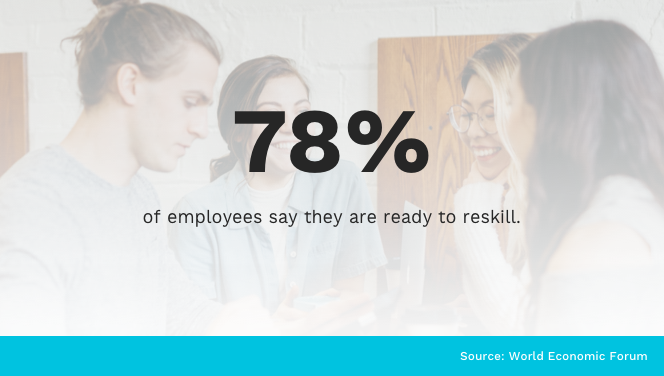
More than 3/4 of employees are prepared for reskilling, so it is an opportunity for you to get the most of your current workforce.
Adapting your recruitment process
Speaking of recruitment, you will probably need to hire new people sooner or later. Before COVID-19, you probably invited candidates to your workplace for on-site interviews, assignments, assessment centers, or even job trials. This will have to have to change if you want to recruit in a way that is safe for you and the candidates alike. Remote recruiting is here to stay, so:
- Digitize your recruitment process if you haven’t already. Candidates should come on-site as little as possible.
- Utilize online assessments to whittle candidates down
- Conduct video interviews rather than face to face (do this for team and peer interviewing too).
- Find ways to provide candidates with the feel for your company culture even if they don’t have an opportunity to visit your office
- Ensure data privacy of your applicants
Over to you
When returning to work, your ‘new normal’ will be a 6-feet economy. In this new post-COVID-19 era, you will need to make many considerations about how to ensure your employees and customers are safe, but also about how to continue operating your business in the most effective way possible. The sooner you accept the new normal and start preparing for it, the better your chances for success are.
